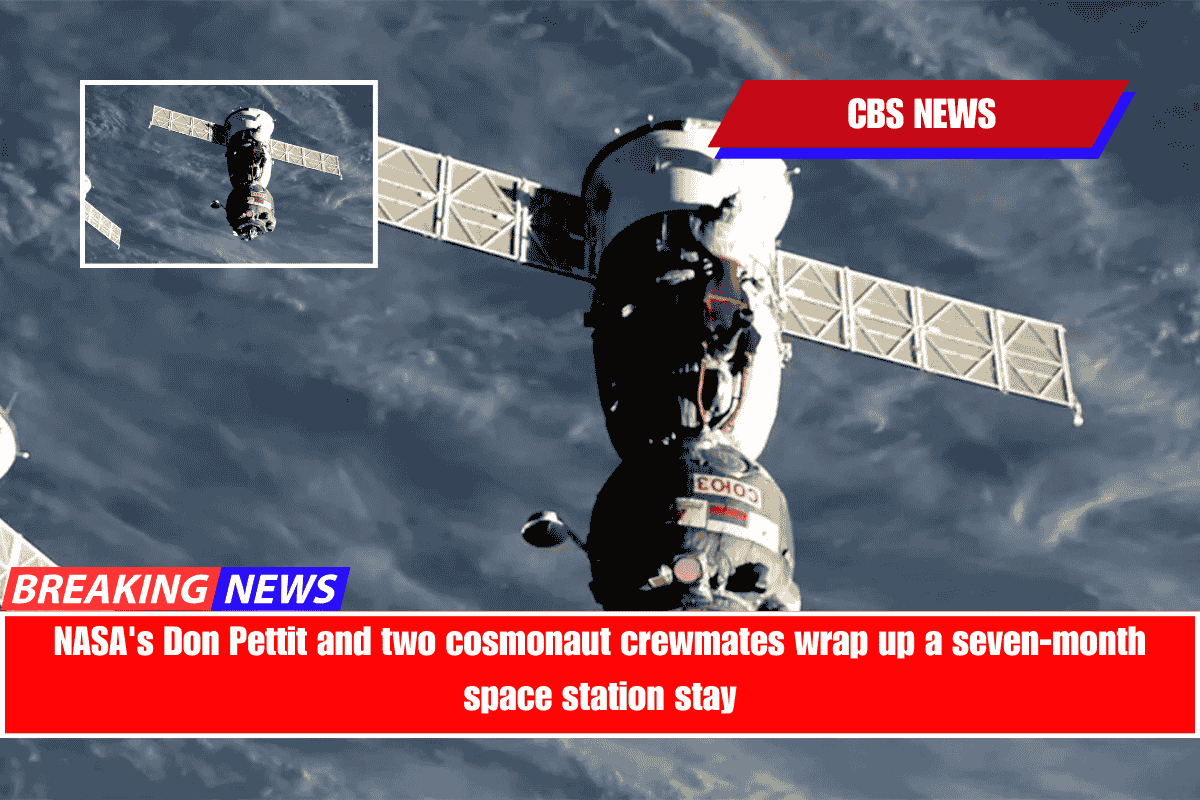Don Pettit, NASA’s oldest active-duty astronaut, celebrated his 70th birthday with two cosmonaut crewmates overnight Saturday, disembarking from the International Space Station and returning to Earth in a blaze of re-entry heat to cap off a 220-day mission.
Pettit, Soyuz MS-26/72S commander Alexey Ovchinin, and flight engineer Ivan Vagner disembarked from the Russian Rassvet module at 5:57 p.m. EDT, preparing for a parachute-assisted landing on the steppe of Kazakhstan near the town of Dzhezkazgan at 9:20 p.m. EDT — 6:20 a.m. local time Sunday, Pettit’s birthday.
Russian recovery crews and NASA personnel rushed to the spacecraft, opened the top hatch, and assisted in transporting the returning crew members to nearby recliners, where flight surgeons performed initial health checks.
Ovchinin and Vagner appeared to be in a good mood, smiling, chatting with support crews, and enjoying drinks and snacks. Pettit, on the other hand, appeared disoriented as he was carried from the descent module, allowing his head to drop back and closing his eyes as he was moved to his recliner. He did not appear again in the landing site video.
But there were no signs of a major problem, medical or otherwise. From Kazakhstan, Ovchinin and Vagner will return to Star City near Moscow, while Pettit will be flown to Houston and the Johnson Space Center for more detailed testing and the start of physical rehabilitation.
In an April 16 interview with KOIN-TV in Portland, Oregon, Pettit stated that he had more difficulty than most when returning to gravity after a long stay in space.
“The very first thing I’m going to do when I get to Earth will probably be to empty the contents of my stomach,” he said, eliciting laughter. “It’s a physiological thing, and it affects different people differently. Some people can land, then go out to eat pizza and dance. When I land, it takes me about 24 hours to feel human again.”
Since its launch on September 11 from Kazakhstan’s Baikonur Cosmodrome, the mission has lasted 220 days and nearly nine hours, covering 3,520 orbits and 93.3 million miles.
Ovchinin now has 595 days in space over four flights, followed closely by Pettit, who has 590 days over four flights of his own. Vagner’s total after two station visits is 416 days.
Cosmonaut Oleg Kononenko holds the world record for the longest cumulative time in space, having spent nearly 1,111 days in orbit over five missions. Peggy Whitson, an astronaut, currently holds the US record. She spent 675 days in space across four flights.
In terms of Pettit’s age, John Glenn, the first American in orbit, was 77 years old when he flew aboard the space shuttle as a NASA astronaut in 1998. He holds the record for the oldest person to fly in orbit.
The return of the Soyuz crew to Earth concluded an extended crew rotation that began on March 14 with the launch of SpaceX Crew 10 commander Anne McClain, Nichole Ayers, Japanese astronaut Takuya Onishi, and cosmonaut Kirill Peskov.
Crew 10’s arrival at the station allowed Crew 9 commander Nick Hague, cosmonaut Alexander Gorbunov, Starliner commander Barry “Butch” Wilmore, and pilot Sunita Williams to return to Earth four days later.
On April 8, the Russians launched replacements for Pettit’s crew — Soyuz commander Sergey Ryzhikov, Alexey Zubritsky, and NASA’s Jonny Kim — allowing Ovchinin, Vagner, and Pettit to return to Earth on Saturday.
In a brief ceremony Friday, Ovchinin handed over command of the station to Onishi.
“It’s a great honor for me to accept the command of the ISS,” indicated Onishi. “I feel very special to be taking over the command from you because we last met here in 2016 during Expedition 48. We were both rookies at the time, but now we are two veterans and ISS commanders.
“Human spaceflight is not easy. Humans could not have gotten here without generations of dedication. Today, we have four rookies on board. “I’m confident that one day they will return and become commanders… that is how we will continue to develop human space flight,” Onishi said.
Since November 2, 2000, the International Space Station has been continuously staffed by rotating crews. The lab, which is scheduled to retire in five years, is dealing with a variety of issues, including air leaks in the Russian segment, uncertain funding, spare parts shortages, and resupply delays.
“Spaceflight is difficult and very risky,” said Rich Williams, a member of NASA’s independent Aerospace Safety Advisory Panel, at a public meeting Thursday. “The ISS has entered the riskiest period of its existence.”
“The ISS management, crew, and support personnel always make spaceflight appear easy. Spaceflight is not easy, and the increasing risks associated with the ISS program make it even more difficult,” Williams said.
The air leaks in the Zvezda module’s aft docking compartment are most likely the result of metal fatigue and repeated pressure cycles as visiting Soyuz crew ships and Progress cargo freighters arrive and depart.
“Primary risk mitigation activities at this point include application and patching materials to known cracks and limiting … pressurization cycles to try to limit stress and fatigue,” Mr. Williams stated. “The ISS program is monitoring this closely, and the panel considers this one of our highest concerns.”
NASA has hired SpaceX to develop a US deorbit vehicle, or USDV, to propel the million-pound space station back into the atmosphere in 2030, ensuring that it breaks up over the southern Pacific Ocean, away from shipping lanes and populated areas. The USDV is expected to arrive in the lab in 2029.
“Delivering and utilizing this USDV capability is critical to ensuring that the deorbit debris risk meets the established government public safety standards,” Mr. Williams said. “If there is a deorbit of the ISS before the USDV is delivered, the risk to the public from ISS breakup debris will increase by orders of magnitude.”
He stated that NASA and Russian space officials are collaborating “to address the challenges associated with achieving a safe deorbit capability, both for end-of-life as well as a risk-managed deorbit for contingencies.”
The main issue confronting the ISS is what Williams described as “a large ISS budget shortfall.” NASA’s fiscal 2024 budget allocated nearly $1 billion for station operations and maintenance, with an additional $1.6 billion set aside for crew launches and resupply missions.
“It is critical to maintain adequate budget and resources until the vehicle has safely re-entered, not only to assure safety of day-to-day operations in a high-risk environment, but also to ensure controlled, safe deorbit within debris footprint requirements for the sake of public safety,” according to Williams.
As a result, he concluded, “the panel appreciates the demonstrated operational excellence of the ISS program, but remains deeply concerned about the increasing and cascading risks attending the program over the next several years.”


















Leave a Reply